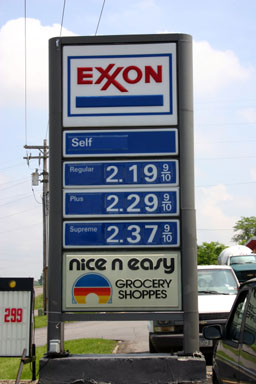May 26, 2004
Gas prices and Dryden
When I was at Town Hall a couple of weeks ago, there was talk that local gas stations had been told to order '3' signs to be ready just in case gas went over $3.00 a gallon. That thought has been echoing for me for a while, and I think it's worth considering what that might mean here.

Today's gas prices at the Exxon at Routes 13 and 366.
Dryden in its current state depends quite thoroughly on cars, trucks, and the gasoline they consume. As I noted a long time ago, my own house, even though it was built in 1929, really only makes sense if you expect to have a car. According to a recent table in the Ithaca Journal, 48.87% of the town's employed residents have a 15-30 minute commute. That's a lot of gasoline every day. (The 3.81% with an hour or more commute must be especially unhappy with prices right now.)
My first question is how much impact higher prices will have on people's driving habits, even if the prices stay high for a long time. These prices are still (if adjusted for inflation) lower than they were in 1980, though that doesn't make people happy when the notice the price has climbed by a third or more in six months. Despite the unhappiness, a lot of the driving here isn't particularly optional - it's commuting to work and grocery shopping. While those activities may get more expensive, I don't expect them to change by much, at least for a while.
In the longer run, I'm guessing that people will be more likely to change their car - if they can - than their house. More efficient cars are available, though whether people will change types of cars is a bigger question. More people may work at home (I already do that), which is another way to cut gas bills substantially. It's also possible to combine trips, carpool, ride the bus, mow the lawn less often...
If this lasts - which sounds possible, given generally rising demand for oil worldwide - I suspect Dryden may see some changes in housing patterns. There may be more opportunities for smaller grocery and other stores that carry fewer items but take less driving, and people may find it more convenient to live nearer centers of employment. The strategy of encouraging development at transportation nodes seems a lot more likely to work when car-based transportation is more expensive.
The Town Draft Comprehensive Plan looks forward "to 2020 and beyond". I don't think its creators can make predictions about transportation trends or their impacts on development, but it does make me wonder if future development might be less scattered than the New Home Construction map for 1985-2000 (256KB PDF).
Posted by simonstl at May 26, 2004 12:43 PMNote on photos